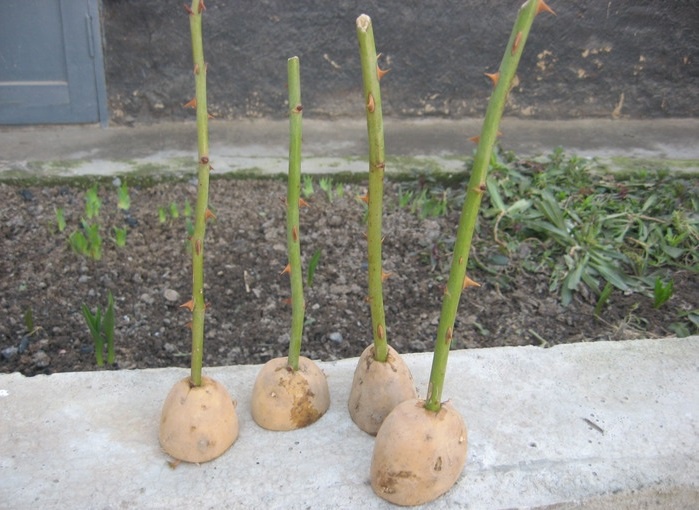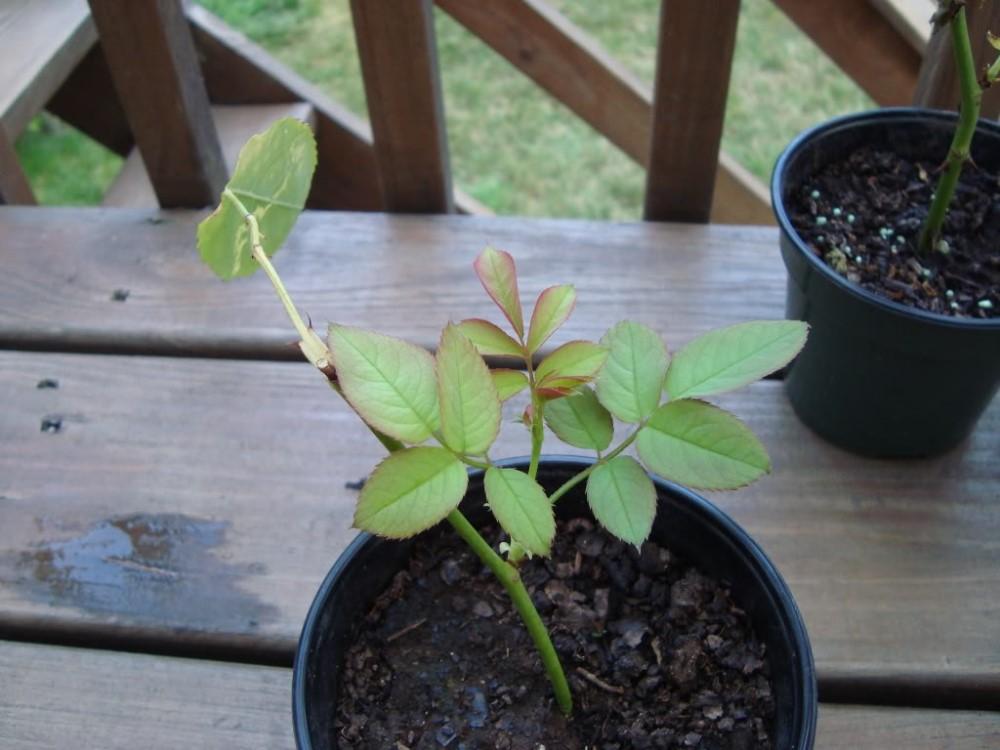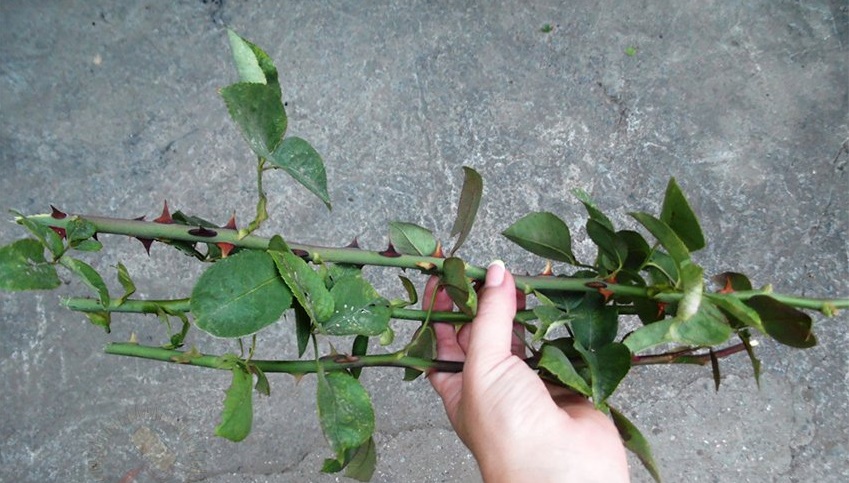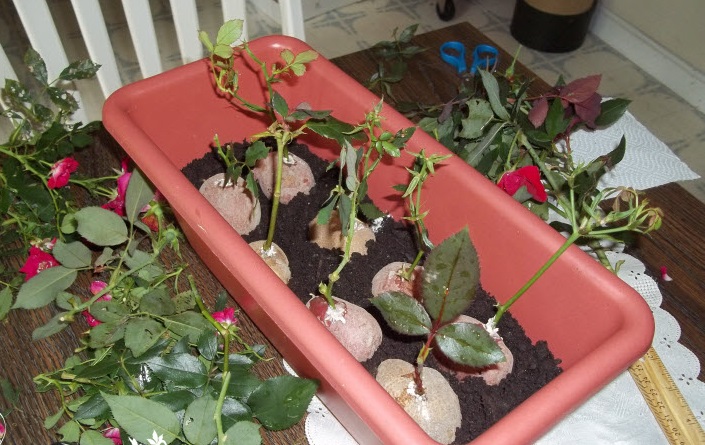How to properly grow a rose in a potato?
Content
Preparing the cuttings and potatoes
In the eternal search for the best and most effective ways of rooting rose cuttings, many materials have been tried, among which the potato tuber turned out to be the most successful. Fresh potatoes contain a wide range of nutrients, especially starch. It is a long-term source of constant moisture and reliable protection against hypothermia, decay, the development of bacterial diseases that sometimes affect roses at the initial stage of growth. In addition, it is technically easy to grow a rose stalk in fresh potatoes.
Before planting a rose in a potato, you should first prepare the tubers and the cuttings themselves. It is better to take young, recently dug tubers as a container for planting roses - they contain the maximum amount of nutrients.
If the stalk is grown in a pot in winter, then the freshness of the tubers is not so important, the main thing is that they are large, dense (not wilted) and without damage. All eyes on the tuber must be removed to prevent germination.
Cuttings (part of the green shoot) should preferably be cut at the end of May, when the rose blooms. For cutting cuttings, it is not recommended to use shoots with unripe buds, as well as with already faded roses, since it is very difficult to root such cuttings - they simply do not take root. Reproduction by cuttings is also possible from a purchased rose (from a bouquet) - there is no fundamental difference. However, it is important that the flower is not grown abroad, since imported roses are treated with a preservative that ensures long shelf life.
The length of the cutting should be 15-20 cm. Thus, 3-4 blanks can be obtained from one rose or one shoot of medium length. Cut the cuttings with a sharp object, preferably with a garden shears, so that the stem does not squeeze when cut. The lower cut is made 2 cm below the kidney at an angle of 45 °, the upper one is 1 cm above the kidney, and the cut itself can be either at an angle or straight. All leaves in the lower part of the cutting must be removed, leaving only a couple of upper leaves.
Further, the cuttings are treated with a weak solution of potassium permanganate for 12 hours, and then placed in a stimulating solution (Kornevin, Heteroauxin) for a day. You can replace these products with fresh aloe juice. After that, the cuttings are stuck in the lower part of the potato. In order not to break the stalk, you can make a hole in the potato with a long sharp object (screwdriver, large nail) and simply insert the workpiece. It should be clarified that the propagation of a rose in a potato is acceptable only for varieties with erect stems. To grow a climbing rose, not a cutting is used, but a layering - a buried shoot rooted in the soil, because growing a layering in a potato tuber is very difficult.
Video "Rooting of cuttings of a rose in a potato"
From the video you will learn how to root a stalk in a potato.
Growing cuttings outdoors
You can root a rose in a potato tuber at home in a pot, or immediately in the open field. The advantage of planting in the ground is that the plant does not need to be replanted, which will allow it to bloom in the same year or next spring. When choosing a site for planting cuttings, it should be borne in mind that roses will grow in this place for several years, so it should be open to the sun and protected from the wind. Further landing technology is as follows:
- we dig a trench 20-30 cm deep (for planting in rows, or for further transplanting to another place) - for planting single bushes without transplanting, separate holes are dug for each plant;
- we pour a layer of sand on the bottom of the pit - this is necessary to exclude contact of the tubers with the ground, and to prevent rotting of the potatoes themselves, and with it the cuttings;
- stick the prepared cuttings into potato tubers, as described above;
- then we place the tubers with cuttings in a trench at a distance of 15 cm;
- We fill the trench 2/3 with earth, lightly tamp it.

A prerequisite for rooting cuttings is to maintain constant moisture. Watering should be regular, but not too intense. For the first time, it is recommended to cover the cuttings with a plastic bottle with an unscrewed cap (to ensure air access). On sunny days, the plants need to be shaded; on cloudy days, remove the bottle completely. After about a month, when the cuttings take root, the shelter is removed.
Growing a flower in a potato at home
The advantage of home growing roses in potatoes is that you can do it at any time of the year. The room is always warm, and if you manage to germinate cuttings in winter, then by the end of spring you can get a full-fledged bush for transplanting to a flower bed, or wait for flowering on the windowsill. To grow roses at home, any containers are used, but, of course, taking into account the further fate of the flower: if it decorates your home, then you should choose a beautiful pot, and if you plan to transplant it into open ground, then even cut plastic bottles will do.
As in natural conditions, it is necessary to create favorable conditions for the germination of cuttings at home. At the bottom of the pots, it is necessary to lay drainage, fill the containers with soil mixture (any store soil for flowers will do). It is good to lay a thin layer of humus on top of the ground, but in order to use the fertilizer in room conditions, it must be disinfected by two or three frosts for 2-3 days. It is also recommended to add to the soil from time to time preparations that inhibit the pathogenic microflora of the soil, for example, Fitosporin, Baikal M-1.
In order for the cuttings to take root sooner, the soil should always be moist, so at home, in addition to watering, it is recommended to additionally spray future roses with water. A glass jar or plastic bottle shelter can help maintain warmth and moisture. After the buds begin to develop on the cuttings, the shelter is removed, and the seedlings are gradually adapted to environmental conditions. Particular attention should be paid to the quality of the lighting, but care must be taken to ensure that the sprouts do not overheat.
Features of transplanting to a permanent place
Rose seedlings are transplanted to a place of permanent growth in the first half of autumn (until mid-October), so that they have time to take root before the onset of winter. It is advisable to prepare pits for bushes 2-3 weeks before transplanting. The size of the planting hole should correspond to the size of the plant's rhizome. If the soil is not fertile enough, then compost should be placed on the bottom of the pit, and then a layer of earth should be poured so that the roots do not come into contact with the fertilizer. Before planting, the pit is well moistened.
It is very important not to damage the roots when digging up a seedling.To do this, the plant must be well watered, and when the soil becomes wet, carefully dig in from all sides, and then remove the bush along with the earthen lump.
Next, the seedling is placed in a planting hole, the roots are straightened and covered with earth so that the root collar rises a couple of centimeters above the soil surface. The earth is tamped, the seedling is watered and mulched with a thin layer of humus. In autumn, plants can be fed with special mineral mixtures for roses without nitrogen content, since this element can cause a rapid vegetative process, which will significantly complicate the wintering of a rose.
Transplanting roses from a pot to the ground is carried out in the same way, with the only difference that the seedlings in pots 2 weeks before transplanting need to be hardened - taken out for several hours outside. For the winter, young plants are covered: the roots of organic mulch, and the bush itself with dense material. Pruning seedlings of the first year of life does not need to be carried out, their shoots are flexible enough, so the branches are simply bent to the ground and covered. In general, cutting roses using potato tubers is a simple, budgetary and quite effective way. Try it in practice and be sure that the result will please you!
Video "How to transplant a rose correctly"
From the video you will learn how to properly transplant a flower.



